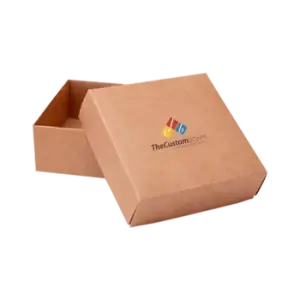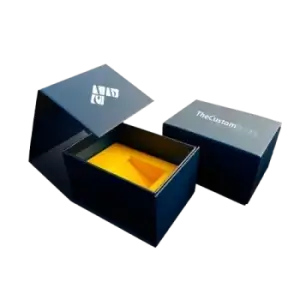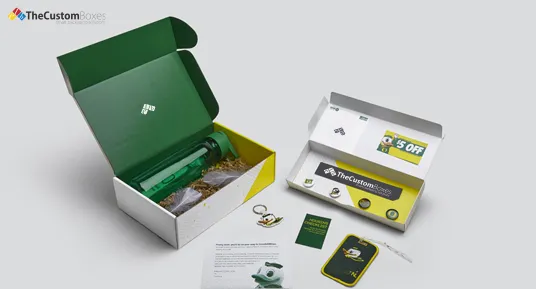Pantone vs. CMYK: A Designer’s
Guide to Branded Packaging
The advancement in the printing world is bringing the great revolution. Brands can get their packaging printed the way they want. Thus, they can make stellar impressions in the market. Various systems are doing a great job in this regard. The two most common and effective are CMYK and PMS. Read on to learn a designer's guide to branded packaging with the key differences between Pantone and CMYK. It will help you to make your packaging appeal more mesmerizing.

The increasing competition urges businesses to opt for attractive and innovative options. This leads to the emergence of branded packaging. In the world of innovative yet functional custom boxes, many factors contribute significantly. One most important of them is the color of the packaging. It shapes customer perceptions and reinforces brand identity. Thus, its selection wants you to be cautious. When it comes to color printing, you might come across various terms. These include RGB, HEX, CMYK, and Pantone. These acronyms are standards and systems. They are used to define and manage colors across different mediums. Their purpose is to ensure color consistency and accuracy. This designer’s guide to branded packaging helps you learn these terminologies with a focus on Pantone vs CMYK. It will also lead to understanding Pantone coated vs uncoated within a Pantone color system. Let’s explore them all one by one.
Understanding RGB, HEX, Pantone, and CMYK:
RGB, HEX, Pantone, and CMYK are of prime importance when working with colors. RGB is an acronym for Red, Green, and Blue. These are three colors that are responsible for creating different colors. You cannot use them for printing because they are only used in digital displays. Commonly, you encounter them while using TVs, smartphones, computer monitors, and other electronic screens. RGB generates various colors by mixing these basic colors (red, green, and blue) at different intensities. Each color range lies from 0 to 255. This allows the screen to generate millions of colors by telling the promotion to mix red, green, and blue colors. JPG, PNG, and PSD are common file formats for RGB. Its knowledge is a must for digital art, web design, and other things that are displayed on screen.
Hex is a short form of “Hexadecimal”. It is a particular type of color code format that represents different colors in web and digital design. As the name indicates (Hexa = six), it contains three pairs of hexadecimal digits. Each pair shows the intensity of basic color components that are red, green, and blue. Thus, it is an abbreviated form of RGB and uses numbers (0 to 9) and letters (A to F). The symbol “#” always comes before the six-digit code. For example, #FFFFFF represents white while #000000 signals black. Contrarily, in RGB white color is written as (255, 255, 255).

Pantone (PMS) and CMYK are the main areas of concern for those who deal with medium printing. This is because both deal with actual pigments rather than colors that light generates in the case of RGB and HEX. In the business world, owners often want to get their boxes printed. It is essential to make packaging informative as well as attractive. In this regard, a clear understanding of Pantone and CMYK is very important for effective results. Let’s dive deep into the Pantone vs. CMYK debate. It will surely help you determine the best for your branded packaging requirements.
Choosing Between Pantone And CMYK: Key To Branded Packaging:

Pantone Definition:
In printing and designs, Pantone Matching System (short form= PMS) finds great applications. It is a standard color system in which pre-mixed inks (Pantone) contain distinctive codes to ensure color consistency across different printers and mediums. To simplify it, it is true to say that you see the same color each time using PMS whether you print on fabric, paper, or plastic. Thus, printers and designers buy swatch books from Pantone Corporation to visualize the final results of inks when printed.
Among various colors, Pantone black is widely used in different industries. Its diversity allows them to cater to varying needs and demands. For example, Pantone Black C (coated), Pantone Black U (uncoated), and many more. The reason for its popularity lies in its consistency and precision. Pantone color for white is achieved by leaving the substrate unprinted. This means the color white Pantone suggests the absence of ink.
CMYK Definition:
In CMYK, C represents Cyan, M symbolizes Magenta, Y shows Yellow, and K stands for Key (Black). The four separate plates of these color inks create a full spectrum of colors. “Process color printing” is the other name for CMYK. It is a traditional printing method that is largely utilized in large-scale production due to its eco-friendliness and cost-effectiveness. AI, PDF, and EPS are the common file formats for CMYK. CMYK Pantone color allows printers and designers to estimate Pantone spot colors CMYK.
PMS Vs CMYK: Key Differences |
|||
|
Sr. No. |
Features |
Pantone |
CMYK |
|
1. |
Consistency In color Appearance |
High |
Medium |
|
2. |
Budget Requirements |
Higher Cost Due to the Use of Pre-mixed Inks |
Lower Cost Needs, Making it ideal for Bulk Printing |
|
3. |
Color Range |
Fixed colors with the glimpse of Unique Shades |
Virtually unlimited because of the great proportionality margin of color mixing |
|
4. |
Special Effects |
Many including fluorescents and metallic |
Limited |
|
5. |
Versatility in Printing Materials |
Best for printing on Diverse materials from paper to plastic and textile. |
Primarily, good for paper-based products like Kraft paper boxes. |
The choice of printing Pantone vs CMKY is different based on particular requirements. However, some packaging designers convert Pantone to CMYK Pantone Connect or vice versa to best meet customers’ needs.
How To Convert CMYK To PMS Or Pantone?

There is no standard CMYK Pantone converter. This is because both differ significantly. CMYK uses four color inks to create different colors during printing. On the other hand, Pantone colors are pre-defined based on the pigment selection. However, for the closest match CMYK and Pantone solid, you can use any of the following tools or software.
1. Convert CMYK to Pantone Color Using Design Software:
a. Adobe Photoshop:
- Open your file in Adobe Photoshop.
- Choose the color picker.
- Input your CMYK values.
- Afterward, select color libraries to switch to Pantone colors.
- Adobe Photoshop will offer the best match CMYK to PMS.
b. Adobe Illustrator:
- Open your design file in Adobe Illustrator.
- Select the area or object where you want to apply color.
- Afterward, select the CMYK color that you need to convert to Pantone color.
- Go to the Window menu and pick from swatches.
- There is a new Swatch button in the Swatches panel. Click it to continue.
- Choose Color Mode. In this case, it is CMYK. Enter your CMYK values.
- Select the Edit Colors Option in the Edit menu.
- Choose Recolor Artwork from the Recolor Artwork panel.
- Afterward, click on the small Swatch Libraries Menu that you can see at the bottom.
- Opt for Pantone Solid Coated or Uncoated present on the relevant Pantone library.
- Adobe Illustrator will provide the closest CMYK Pantone match to the users.
You can use the above software for Pantone color to CMYK conversions. For this purpose, select the Pantone colors and alter the color mode to CMYK. The results will be the CMYK equivalent to pantone.
2. Online Conversion Tools:
Various online tools are available to convert CMYK to Pantone. They allow you to carry out various conversions including RGB to Pantone matching system. Also, hex to pantone calculator is there to assist the conversion. You can use EasyRGB, MyCraetiveShopConverter, Nic Color Tools, and many more.
3. Manual Matching:
If you are not ready to use any software or tool, there is another way out for you. Just use Pantone color CMYK swatch books. Find the closest match manually by physically comparing printed CMYK samples to Pantone swatches.
When to Use Pantone:
Due to higher color consistency, Pantone is best for the following aspects:
- Luxury packaging is used for premium products. These include jewelry, cosmetics, watches, and others. Pantone offers uniqueness and vibrancy in shades. Thus, it elevates the appeal and unboxing experiences.
- Pantone is best for brands that convey brand identity by opting for consistent colors. It ensures the same shade across all materials.
- Use Pantone for advanced designs. Surfaces that require neon or metallic tones should utilize this.
When to Use CMYK:
CMYK is famous for its cost-effectiveness and eco-friendliness. Thus, use it for the following outcomes:
- Mass production because of its affordability and efficiency.
- As compared to Pantone, CMYK is better at offering complex designs with great precision. It allows you to handle photographic images, intricate artwork, and gradients effectively.
- Eco-conscious brands should opt for this. The reason is CMYK contains sustainability inks that add no harm to the environment.
Coating Vs. Uncoating Printing Surfaces:

After your informed selection about CMYK or Pantone, it is time to take the next decision. It is Coating vs. uncoating. When it comes to color printing, there is a significant difference between the two. Coated Pantone colors are represented as “C” while uncoated as “U”. They signal the type of surface of the materials on which printing is required or done. Coated colors are richer and eye-catching while uncoated colors are muted and subtle.
Both color types require different conditions to offer an accurate match. This is because every substrate absorbs different amounts of ink. Thus, for accurate color reproduction, Pantone codes are good solutions. Coated for a lavish look and uncoated for a faded appeal. However, a question may arise here: can coated and uncoated pantones be printed on same sheet? Well, technically it is possible but various factors must be considered in this regard. Paper type and finish are important to consider. Otherwise, it will affect the color consistency in the results. To avoid this, it is mandatory to communicate with the designer and color proofing.
Combining Pantone and CMYK:
Sometimes, designers use both systems at the same time in a single project. For example, brands want their logo to appear more inviting. For this, Pantone is best for ensuring consistency in printing. Printing the whole packaging with Pantone often seems expensive to them. Thus, they prefer other design elements to be printed with CMYK. This hybrid is best for those looking for affordability and precision simultaneously.
Final Thoughts:
The debate on PMS vs CMYK is long. It depends on the particular needs and preferences to choose a particular one. Both systems have their own strengths and weaknesses. Pantone is the green signal for brands that prioritize novelty and consistency. On the other hand, for those who want affordability and versatility, CMYK is the way to go. Understanding these systems opens up new doors for creativity and innovation, leading to branded packaging. Thus, the above blog post allows businesses to pick the one that better matches their values and requirements. The Custom Boxes stand with all those brands who want branded packaging to create a stunning impact under their budget. So, get in contact with us through our free customer support if still there is a query bothering you. Also, our free shipping services on bulk orders allow you to meet your desired packaging more affordability.
FAQs:
Do pantones start with f?
Yes, pantones start with F. The F pantones are critical reference.
What is the Pantone?
To define Pantone, it is a global or standardized color matching system. It allows brands and designers to ensure color consistency during printing.
















